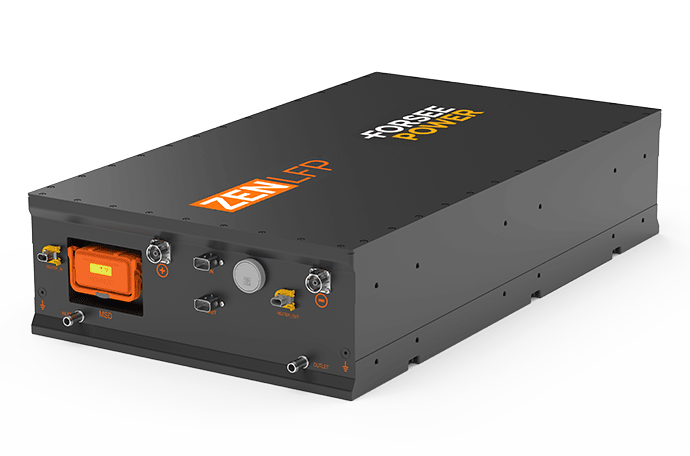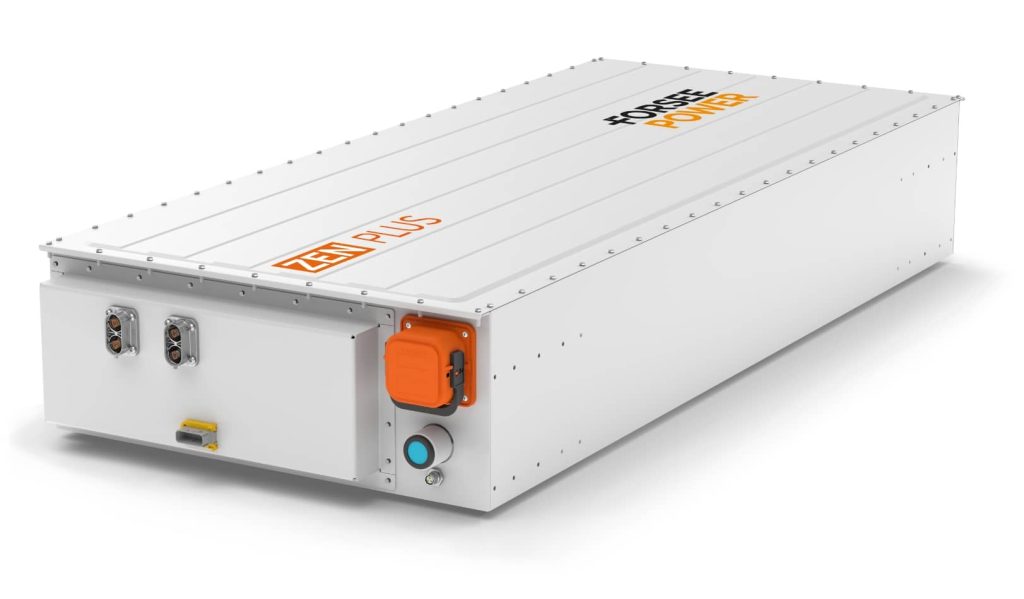What is a high energy battery?
A high-energy-density battery is one that can store a large amount of energy in a compact space. Energy density is typically measured in watt-hours per kilogram (Wh/kg) or per liter (Wh/L).
A higher energy density means a battery can store more energy for the same mass or volume, a crucial factor for heavy vehicles.
These batteries are primarily lithium-ion, but new technologies like lithium iron phosphate (LFP) batteries are gaining traction. They not only extend the vehicle’s range but also reduce its overall weight, thereby increasing the overall efficiency of transportation.
In the heavy transport sector, energy density is essential for minimizing battery weight while maximizing vehicle range. This helps reduce the number of recharge cycles and optimize the operational performance of vehicle fleets, while also contributing to sustainable mobility.

High energy batteries for electric buses
Improvement in range and capacity
The use of high-energy-density batteries in electric buses enables them to achieve sufficient range to cover an entire day of operations with a single charge. These batteries also ensure optimal passenger capacity without significantly increasing the vehicle’s overall weight, which is crucial for high-demand urban services.
Several modern buses equipped with next-generation lithium-ion batteries can reach ranges of 300 to 400 km (186 to 249 miles) on a single charge, depending on usage conditions and vehicle configuration.
Reduction of emissions in urban areas
The adoption of high-energy-density electric buses directly contributes to the reduction of pollutant emissions in urban environments. Electric fleets are increasingly supported by local regulations aimed at decarbonizing transportation.
Many municipalities are planning to replace their entire fleet of conventional buses with electric ones by 2030.
The increased efficiency of high-energy-density batteries helps meet these goals by reducing both CO2 emissions and noise pollution.
High energy batteries for electric trucks: a key driver for decarbonized logistics
Performances and autonomy
Electrifying trucks is one of the most complex segments due to the high demands for payload capacity and range. Thanks to high-energy-density batteries, electric trucks can now travel up to 800 km (about 500 miles) per charge while maintaining load performance comparable to diesel trucks.
These batteries significantly enhance the energy efficiency of vehicles by reducing kWh consumption per kilometer traveled. They also improve energy recovery during braking phases, which extends their effective range.
Reduction of operating costs
Electric trucks equipped with high-energy-density batteries not only reduce greenhouse gas emissions but also lower operating costs, particularly through fuel savings and reduced maintenance expenses (fewer moving mechanical parts to replace).
Additionally, regulations aimed at limiting CO2 emissions in heavy transport are making these vehicles increasingly attractive for logistics operators.
The continuous improvement of fast-charging infrastructure is also a key factor accelerating the adoption of electric trucks. Ultra-fast charging stations designed specifically for heavy vehicles are being deployed, especially along major highway routes.
Electrification of trains made possible by high energy batteries

Substitution for overhead lines
In some regions, the installation of overhead electric lines (catenaries) to electrify railways is not economically viable. Battery-powered trains become an efficient alternative in these cases. High-energy-density batteries enable these trains to cover medium distances without being connected to external infrastructure, reducing both infrastructure costs and direct emissions.
For non-electrified rail lines, especially in rural areas or regions with low traffic density, high-energy batteries provide an immediate solution for the rail sector’s energy transition. Battery-equipped trains can also operate in a hybrid mode, using both battery power and catenaries when available.
Energy efficiency
Battery-powered trains can recover a significant portion of energy during braking (through regenerative braking systems), which enhances their overall energy efficiency.
Additionally, the performance of these batteries is sufficient for regular journeys with intermediate stops for recharging, thereby reducing reliance on fossil fuel energy sources.
Charging modes for high energy batteries in heavy electric vehicles
The efficiency of high energy batteries in heavy vehicles does not rely solely on their ability to store more energy. Charging modes also play a crucial role in their operational performance and widespread adoption.
In the context of electric buses, trucks, and trains, there are several charging technologies that address the specific needs of heavy transport, each with its own advantages and challenges.
Slow (or overnight) charging
Slow charging is the most common method for heavy vehicles such as buses and trucks. It typically takes place overnight (usually between 8 and 10 hours) when the vehicles are out of service, using alternating current (AC) infrastructure.
One of the main advantages of slow charging is the reduction in energy costs, as electricity is often cheaper at night.
Additionally, this charging method puts less stress on the batteries, which can help extend their lifespan.
Opportinuty charging
Opportunity charging, or en-route charging, involves recharging the batteries during frequent or scheduled stops, such as at bus stops or logistics terminals. This charging method is advantageous because it maximizes vehicle usage time. Charging takes place during stops that are already part of daily operations, allowing vehicles to remain in service throughout the day without requiring long breaks for recharging.
One of the challenges of opportunity charging is the need to install charging infrastructure at several key points along the route, which can be complex and costly. Additionally, careful planning is essential to ensure that vehicles can access the charging stations at critical moments.
Hydrogen refueling
Hydrogen refueling, which uses fuel cells combined with batteries, represents a hybrid solution. Hydrogen is converted into electricity to power high-energy-density batteries, providing extended range for heavy vehicles.
One of the primary advantages of this technology is its ability to offer long-range capabilities for heavy vehicles, allowing them to cover long distances without the need for frequent recharging. Additionally, using hydrogen as an energy source produces only water vapor, making it a clean and environmentally friendly solution.
However, the infrastructure required to produce, store, and distribute hydrogen is still underdeveloped and expensive to implement.
Despite its potential, this technology is less widespread than high-energy-density batteries alone and requires further research to become a widely accessible alternative.

